What is the Strategic Pricing Gateway?
Strategic Pricing Gateway (or the gateway) can be used to understand how your volumes and prices are connected to the market you’re in.
The Pricing Gateway offers an excellent and simple way to understand what your optimum price point for profitability is and how your demand curve is changing in relation to the market price.
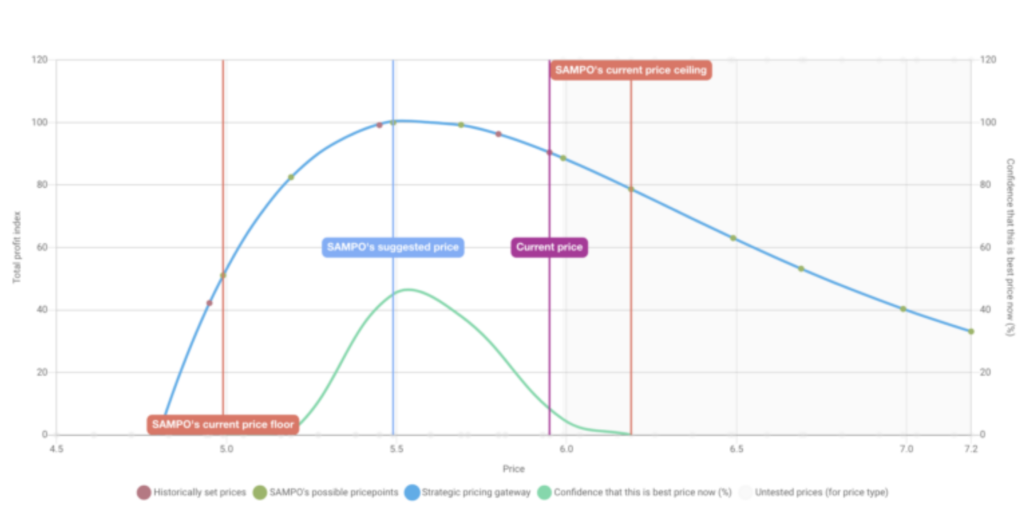
The gateway gives you simply minimum and maximum boundaries and your pricing should be done within those boundaries. If you go under or over the boundaries you are going to be losing money. Stay on the middle and you´re making the best profit. This concept is especially helpful for price optimization and keeping your pricing competitive.
“Think about it: If the competitor is pricing his products blindly, should you follow that model? Probably not.”
With Pricing Gateway you make sure that you have the right momentum on the market. This is not a gimmick we invented, it´s a simple tool based on price elasticity and market elasticity. When you envision your pricing as a gateway, you can easily think of it as an airplane flying in a secured tunnel. Go too high or low and your run into trouble Stay in-between the boundaries and you´re good to go.

How does the strategic pricing gateway work?
As explained above the Strategic Pricing Gateway needs three pieces of information:
- Competitor pricing
- Your sales volumes and pricing
- Your costs base divided for the product
It goes without saying that the most successful eCommerce companies will take all three into consideration when planning their pricing strategies. The powers of Pricing Gateway is simple. You get an understanding of where your optimum price point lies and what are the minimum and maximum margins you can have. Not knowing these means that you are either leaving margins or volumes for your competition.
To start you will need to monitor market pricing of your competitors. This lets you understand what the real market prices are. The other thing you need is your pricing and sales volumes for each product used in this concept.
Remember that you will reach the best outcome when you do price testing to understand the price elasticity (how volumes change when price changes) of your products. Lastly you will need the cost base divided into a single product. This can be done in several ways, but in the simplest, you can take the same percentage of costs as the product is responsible for sales.
“Your cost structure determines you strategic pricing gateway.”
Strategic pricing gateway calculated
First you need to understand how your volumes will change if you change your pricing. This concept is called price elasticity. (Feel free to download our tool to calculate your price elasticity). With price elasticity you can estimate your demand curve (see picture 1.). Demand curve will tell you that how much your price increase or decrease will affect on your volumes.
Now that you have your demand curve drawn you can calculate your profit curve. This can be done by calculating a curve where you compare your gross profit against your price. Finally, you compare that to your demand curve (see picture 2.) to understand where your limits are. First your cost base will set the hard boundaries to your pricing. Then you must determine the minimum acceptable margin that you cannot cut. Now you have minimum profit determined. When you compare the minimum profit to your demand curve you will notice that if you raise the price high enough the volumes will drop to the level where your gross profit drops to the same level as in the case of minimum margin. This point is called maximum margin. After that point increase of prices will drop volumes so much that you will do a loss with every single product sold.
In between minimum and maximum margin boundaries is a point where the number of the products sold multiplied with the gross margin is the highest possible. This point is called optimum price point. Keeping prices always on this point will yield the best possible profit.
The market will determine your strategic pricing gateway
Strategic Pricing Gateway is not a permanent position on the market. It is a dynamic (that’s why we have developed automatic tools for that) gateway which is highly dependent on your demand curve position. Let’s say that your market has four competitors and each of them sell the same product with prices ranging from 90€ to 100€. In that case your demand curve will be highly dependent on that market pricing. But if someone changes their pricing permanently to 80€, it means that your demand curve will spread out further and eat volumes from competitors staying at 100€. eCommerce companies who utilize pricing gateway approach will have a huge advantage over those who follow competitors blindly. They understand how customers react on pricing and how much this will have impact on volumes. This enables faster growth and better profitability.
Understanding price elasticity
The strategic pricing gateway is a concept we developed to help our customers. It is no new invention, we just made it an approach to visualize the unseen force on the market: consumer demand. To utilize this tool you must understand how your products differ in terms of price elasticity. Let’s take another example and compare two different product types: inelastic and elastic. Inelastic is a product type where relative change in volume is smaller than the relative change in price. A good example of such a product would be a critical medicine. No matter if it costs 100€, 1000€ or 10000€ the demand is still the same (see picture 3.).
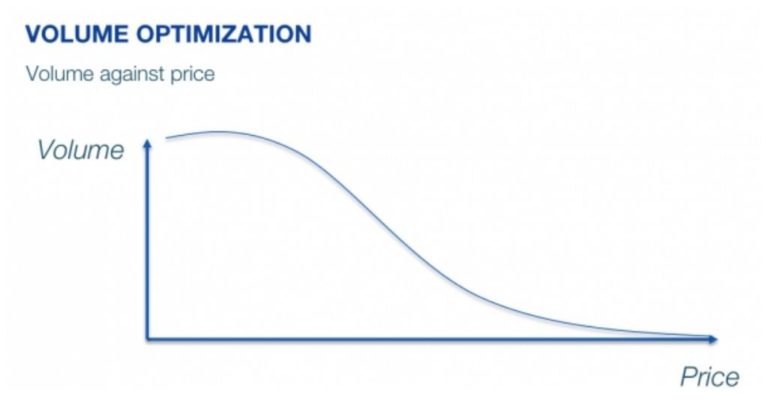
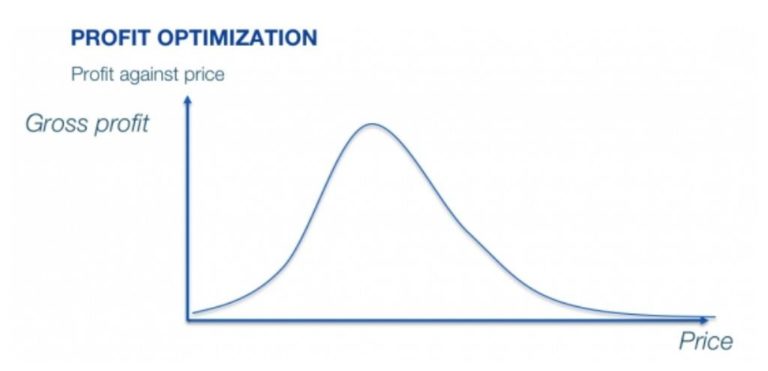
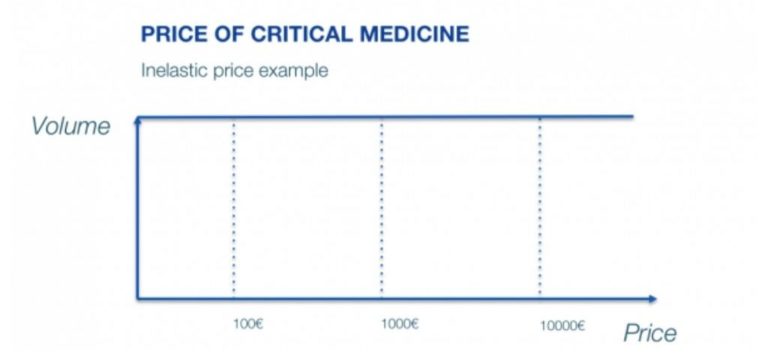
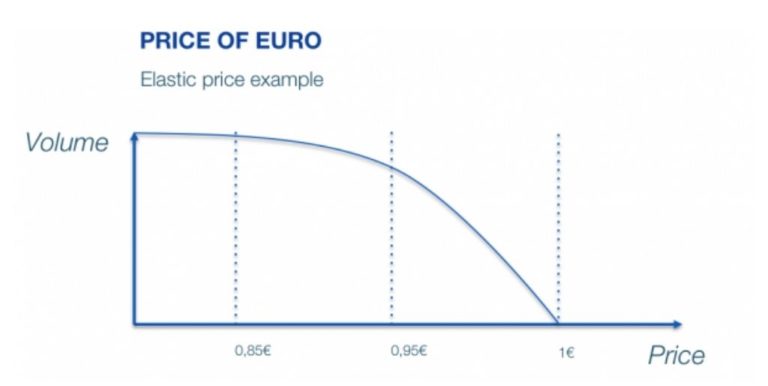
But if we compare that to a perfectly elastic product such as Euro coin (see picture 4.) the difference is clear. If I were to sell you a 1€ coin for 0,99€ you would buy all I have. Lowering the price even further would turn the now elastic curve to even inelastic as people would buy all your euros enabling them to get wealthier. Between 0,95€ and 1€ most of us would suffer from financing problems and thus still keep the curve elastic. Although the example is simple, it does paint you the point. The price of a product has a major impact on how many pieces people will buy in a perfect market. Naturally if you are selling potatoes in a country where everyone is allergic to potatoes, it will not give you the same curve as in a perfect market. When calculating price elasticity you should consider following aspects:
1. Product type, category and characteristics
2. Market size
3. Competition
4. Consumer characteristics
5. Availability
Why should you care about the strategic pricing gateway?
The theory behind the strategic pricing gateway sounds complex, but with simple tools you can easily understand where your gateway lies. That enables your product and pricing teams a safe, dynamic and easy gateway in which to do pricing. Because all pricing actions done in your company have an overall effect on your company’s profitability and sales of other products, it is vital to understand what is the optimum price and which are the gateway boundaries to keep your product pricing profitable.
The web has become a market place, where Amazon is in the next booth and each product is turned into a commodity that can be easily compared. There are five forces that form a tailwind for the growth of the importance of price.
1. Growth of mobile shopping
2. Faster logistics
3. Market place price competition
4. Retailer loyalty decreasing
5. Ad block growth & privacy
Where to start
So now we know what the theory is. So what. You should get it into practice and fast. So let’s recap and give you a few tips on how to start. You need the following data:
1. Price monitoring and understanding of the market
2. Volume data about your products
3. Cost structure per product
4. Simple tools
You can easily collect the market data with price monitoring tools like Sniffie. The volume data you should easily get from your ERP or even Google Analytics. Make sure you collect those prices daily against the price those were sold with. Only then you can calculate how a price change affected on volumes. Your cost structure you can determine as you best see fit, but be realistic how much one product should yield for your overall profitability. Finally, use simple tools like our Gateway Excel and understand where your Strategic Pricing Gateway lies.
Checklist for setting up a Strategic Pricing Gateway
1. Pricing gateway models
Pricing gateway models should be built on the understanding on what is your overall marketing strategy. If you want to be a higher end value added pricing retailer, you naturally will not fight with volumes. Then you want to optimize profit. On the other hand if your marketing strategy is to be a cost leader in the industry your strategic pricing gateway will be optimized for volume.
2. Calculations
Calculations are good but testing is better. Understanding the real elasticity also means taking into consideration imperfect market information such as: marketing, imperfect information, bad competitor SEO and other relevant factors. So make sure that you have done your homework around the market competition before doing the calculations.
3. Monitoring
In today’s eCommerce it is unrealistic that you would survive with some kind of monitoring. Your customer can at any time google your products and find market pricing for those. If you are selling 100.000 items, for you googling those from your mobile is unreal. Using tools like Sniffie will help you to get an automated and structured view of the market.
4. Time to time rechecking
Understanding that pricing gateways move and change is vital. Recheck your volumes and if any change is seen take into consideration if you should calculate again where your strategic gateway lies.
Wrap-up
Strategic Pricing Gateway will help you to optimize your pricing. Without doing that you will always leave money on the table in terms of lost volumes or margin. Make sure you get more power to your pricing by harnessing the simple concept of pricing gateway.


